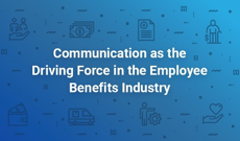Numerous research shows that the role of benefits in recruitment and retainment keeps growing from year to year. More people tend to make a decision to take the job or to leave the company, depending on what their employer has to offer in regard to health insurance. Hence, more companies have to learn to see benefit guides not as secondary supplements but as strategic tools, and then treat them as such. And this includes not only the materials production but also their distribution.
As a method to distribute documentation, printing has always been perceived as solid and dependable. Even now, in the midst of the digital era, lots of insurance brokerages still heavily rely on paper, no matter the cost.
But is it actually worth it, keeping the flame of tradition alive? Is it good enough to help you keep up with this fast-paced, ever-changing world? The honest answer–no, it isn’t. You might not feel it yet, but printing your materials is actually holding you back.
Reasons Why Printing Documents May Be More Trouble Than It Is Worth
There are at least four reasons that you shouldn’t hold on to printing as the sole method of the content distribution.
#1 Shipping costs a fortune
If you’ve ever printed anything in bulk, you know how expensive it is. And shipping is even more so. Even if you’re a small agency under 100 people, just one client with lots of local offices and remote workers can come to $1,000-2,000 a year. Money is not the only currency you pay, though. It also comes at a cost of man-hours–first, to produce the content, and then to deliver it to clients. And during the enrollment period, you can’t overestimate the value of time.
#2 To err is to pay (even more)
If your only way of your employee materials distribution is printing, then you’ve long since gotten used to reprints. Be it a mistake, a typo, or a sudden change in an insurance policy, you have to rectify it. After all, company materials are usually available to employees for a whole year, up to the next enrollment. Therefore, they have to stay relevant. And you have to reprint hundreds of documents at a time. This, naturally, costs you another heap of money.
#3 Trash-material
What happens to a printed handout once it reaches its final destination in an employee’s hands? At best, it’s browsed through, then tossed away. At worst, it goes straight to the trash because an employee decides that they don’t need it. For a lot of people, it’s just waste paper: they don’t have the time or inclination to go through or fill out a bunch of papers. And thus all your time and money spent on printed guides are wasted, too.
#4 Impossible to improve customer service
With printing, there isn’t much room for improvement or development when it comes to customer service. You print the content your client approved; you send it; and that’s pretty much end of story. And that’s not enough, not as the job market has become much more candidate-driven and continues to move further in that direction. The more personalized your approach gets and the easier you make it for a client, the more you stand out among your competitors. Customization, interactivity, and mobility–those are the things that are big differentiators in the game now. But they are so much harder to reach if printing is your only option.
Alternative
So, if printing doesn’t cut it, what’s the alternative? Well, going digital sounds like an obvious and reasonable choice. Check out how your digital content can look.
Create yours
With your docs turned digital, you don’t have to spend a ridiculous amount of time or money on printing and shipping. Instead, you just send them via email. It definitely solves the problem of delivering your materials to remote locations. And if you notice an error post factum, you don’t have to reprint–you simply send the file once more. Then the information always stays current.
Employees are more likely to scroll or flip through a mobile-friendly online document on their way to grab lunch than they are to carry around a paper copy of the same document. However, should they want a paper copy, any digital content is easy to print out.
And if your online solution is a bit more sophisticated than a PDF, you can actually do a lot of things with it that will make the process of choosing and delivering the right benefit plans so much more intuitive for your clients. For example, you can insert links to valuable sources, doctor networks, and contact information. Or, you can track statistics. That way, you’ll see how many views each publication gets. If one doesn’t get any, you know that the employer has probably forgotten to share the document, and you can remind them to do so.
Technology smartly implemented into everyday life and its tedious tasks to make them simpler and slightly less tedious–it’s not only what millennials want, but it’s also the future. If you can do that for your clients, you’re way ahead of most brokers.
What Now?
Of course, no one says you should make drastic changes in your workflow routine all at once and completely eliminate printing. Go halfway. At least, give it a try. Find an online tool or software that suits your needs best and next time, suggest a digital version of the publication to your long distance client who might be willing to try something new. See how it works out. Maybe you won’t see a difference. But we’re pretty sure you will.
How can you step away from printing?
Create digital documents with FlippingBook today – leave high printing costs and time-consuming production behind.





